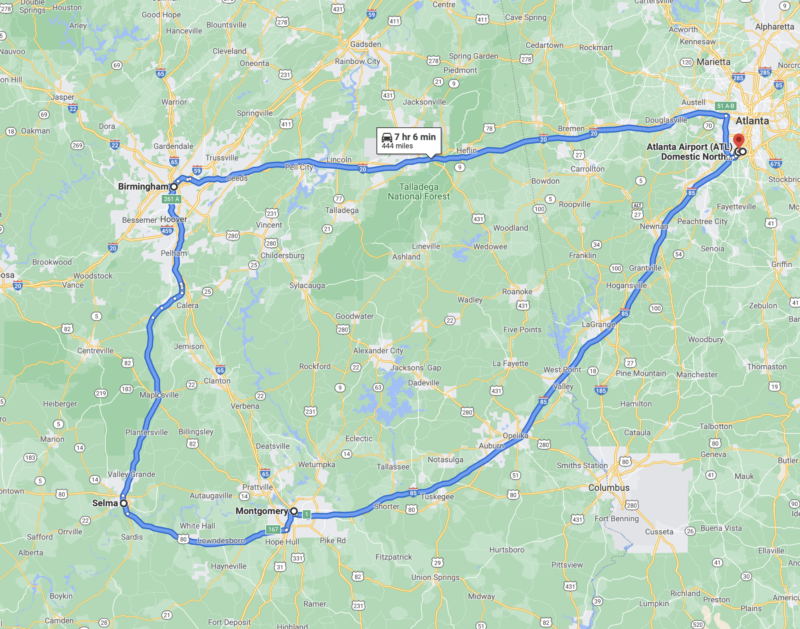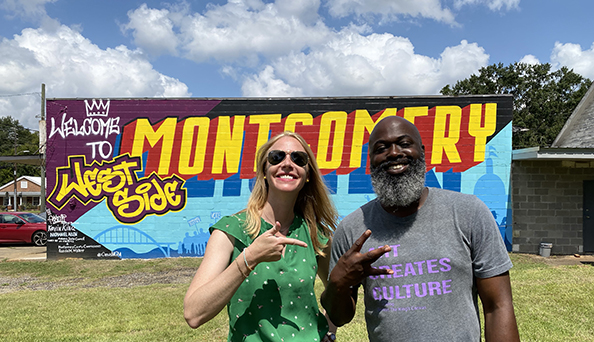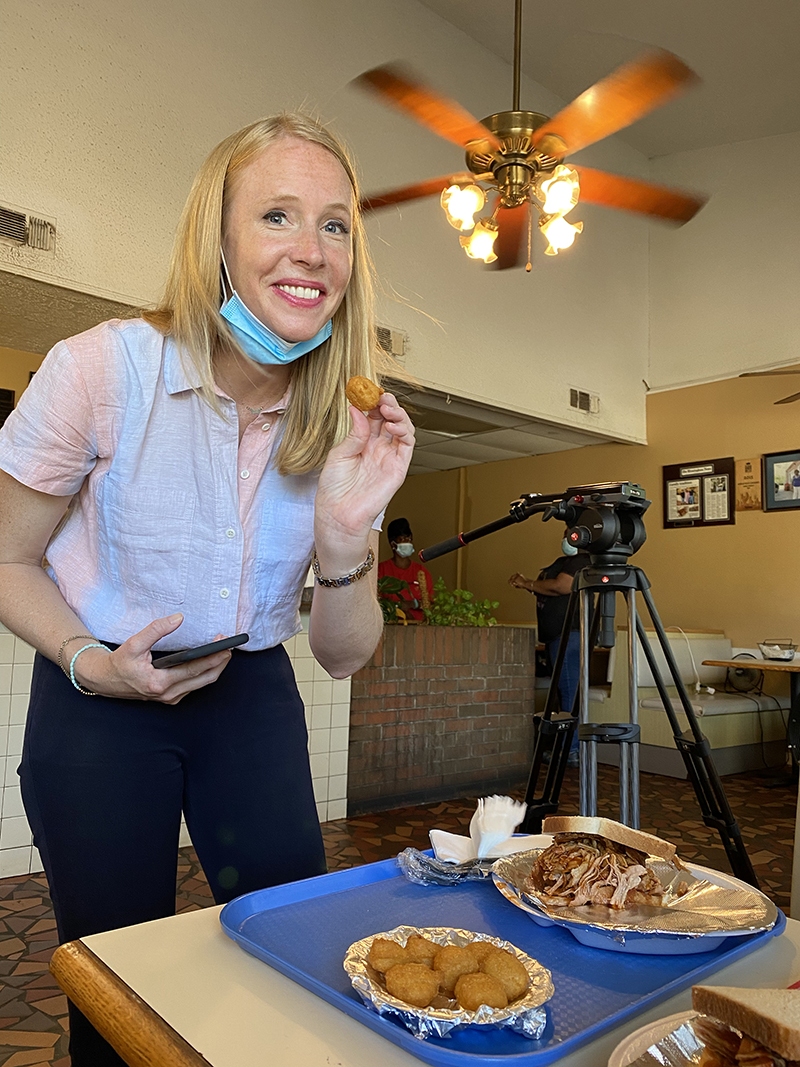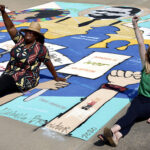Don’t miss these Alabama’s Civil Rights Trail Sites in Montgomery, Selma and Birmingham. I recently presented a Smithsonian Associates program on Alabama’s Civil Rights Trail. While you can follow this simple 5 day/ 4 night itinerary on your own or book it through our preferred travel agent or your own, you can also expand a trip to include some or all of the below.
I’ve also suggested great restaurants in each location, and you can see videos from these Alabama Civil Rights Trail restaurants and breweries at this link. See our post on top tour guides to take you to these sites on a guided tour, too. Thinking of taking the U.S. Civil Rights Trail in other states? Check out the U.S. Civil Rights Trail website and the new book by Lee Sentell, the founder of the U.S. Civil Rights Trail.
Make sure to check the website of each destination before visiting to make sure of the hours, whether you need tickets and if they are open during COVID.
Alabama Civil Rights Trail Brief Background
During the 1950s and 60s, Alabama was a hotbed of activity surrounding the Civil Rights movement. Selma, Birmingham and Montgomery took the world’s stage and came into national and international homes following bombings and brutal attacks at churches, homes, bridges and beyond. Much violence and many of the victories took place throughout the American South during this time period, where people of diverse backgrounds came together to make change.
Montgomery, Alabama Civil Rights Trail SitesMontgomery, Alabama was a city of major activity during the Civil Rights Movement. The below sites will help you contextualize what happened in Montgomery and beyond.
- Alabama State Capitol
- On March 21st, 1965, Dr. Martin Luther King Jr. led thousands of demonstrators on a 5-day, 54 mile march from Selma to Montgomery, where they would congregate at the steps of the capitol on March 25th. Dexter Avenue King Memorial Baptist Church. Walk from Dexter Avenue King Memorial Baptist Church to and up the Capitol steps and take in the view to visualize what the marchers would have seen. There’s a marker with a photograph between the church and the Capitol.
- Dexter Avenue King Memorial Baptist Church
- The church where Dr. Martin Luther King served as pastor from 1954 to 1960. From his office in lower part of the church, Dr. King also directed civil rights activities, including the 1956 Montgomery Bus Boycott. If you can have Wanda Battle lead you on a tour here, do.
- Dexter Parsonage Museum
- The home where Dr. King lived when he was pastor of Dexter Avenue Baptist Church. A plaque on the front porch reminds visitors of the Jan 30, 1956 bombing of the King family’s home and all that they endured for freedom and equality. It’s located at 309 South Jackson Street in Montgomery.
- The Harris House
- The Harris House is on the same street as the Dexter Parsonage Museum. Dr. Richard H. Harris Jr. and his family welcomed into their home 33 Freedom Riders, groups of volunteers who made history by challenging the practice of segregated travel throughout the South. Make an appointment for a tour or just go and see the historical marker outside.
- Freedom Rides Museum
- The Montgomery Greyhound bus station, now a museum, shares more about the history of volunteers who made history by challenging the practice of segregated travel throughout the South. It’s located at 210 South Court Street in Montgomery.
- The Ben Moore Hotel/The Malden Brothers Barber Shop
- At the time of this article’s publication, you can only tour the Barber Shop by appointment. It’s located at 902 High Street, Montgomery. The Ben Moore Hotel dates back to 1945 and was the site of historic meetings between representatives of the black and white populations of Montgomery during the Civil Rights Movement.
- Rosa Parks Apartment
- See this apartment in “Travels with Darley: Alabama’s Civil Rights Trail Episode II.” It’s on the National Register of Historic Places, but not yet open to the public. It might be soon!
- Rosa Parks Museum
- Features a restored bus and other artifacts related to Civil Rights icon Rosa Parks. It’s located on Troy University’s Montgomery campus at 252 Montgomery Street in Montgomery.
- The Legacy Museum
- Located on the site where enslaved people were once warehoused and sold, the Legacy Museum offers the opportunity to reflect on the history of slavery, racial injustice and its effects on society. It’s located at 400 North Court Street in downtown Montgomery.
- The National Memorial for Peace and Justice
- Recognizes the thousands of lynchings that occurred across the U.S., many of which were undocumented.
- City of St. Jude
- The hospital in this enclave, which included a church and school, was the first in the Southeast to integrate. Offered refuge to 2,000 participants of the Selma-to-Montgomery March.
Other Montgomery Civil Rights Sites, below.
- Trinity Evangelical Lutheran Church
- Holt Street Baptist Church
- Mount Zion African Methodist Episcopal Zion Church
- Holt Street Baptist
Check out more sites at the U.S. Civil Rights Trail website for Montgomery.
Selma, Alabama Civil Rights Trail Sites
Selma, Alabama was the site of much social justice activity and tragedy during the Civil Rights Movement. On March 7, 1965, hundreds of Civil Rights marchers tried to travel out of Selma on U.S. Highway 80 over the Edmund Pettus Bridge. They were peacefully marching for voting rights with civil rights activist John Lewis as one of their leaders. At the bridge, state troopers and a posse of lawmen were waiting to stop them. Selma’s ‘Bloody Sunday’ would mark a shift in the Civil Rights Movement. Head to Selma to continue this story and learn about what transpired at churches, restaurants and on the Edmund Pettus Bridge. Enlist local Selma tour guides to help you on your journey.
- Edmund Pettus Bridge
- The site of the brutal Bloody Sunday beatings of civil rights activists during the first march for voting rights. Part of the Selma to Montgomery March Route. There is traffic on this bridge, as it is a working bridge. We do recommend taking your own walk over the bridge and learning about the history before you do. There’s a historical marker at the foot of the bridge and you can get good photos of the bridge from Selma’s Historic District.
- Brown Chapel AME Church
- The site of preparations for the march from Selma to Montgomery. This church is across from the George Washington Carver Homes. It also hosted the Southern Christian Leadership Conference (SCLC) for the first three months of 1965. There’s a historical marker outside of the church.
- George Washington Carver Homes
- Many families lived in these homes that were participants in the Civil Rights movement. Dr. King, the Southern Christian Leadership Conference (SCLC), the Student Nonviolent Coordinating Committee (SNCC), and other organizers often lived with families while fighting to secure the right to vote.
- First Baptist Church
- A few blocks away from Brown Chapel is First Baptist (Colored) Church. Located at 709 Martin Luther King St. it’s one of the first churches in the area to host meetings held by the Student Nonviolent Coordinating Committee (SNCC) and the Southern Christian Leadership Conference.
- Historic District of Selma
- Make sure to see Carter Drug Co. at 133 Broad St. This area is bounded by U.S. Route 80, Broad and Franklin streets, and Dallas and Selma Avenues.
- St James Hotel
- Located at 1200 Water Ave. adjacent to the Edmund Pettus Bridge on the banks of the Alabama River, this historic hotel was built in 1837.
- The Coffee Shoppe
- A 1960s diner, The Thirsty Boy, it was a segregated diner. Today it’s a black owned business where Jackie Smith has made the segregated window into a positive display of hope. Great local coffee and you can walk from The Coffee Shop (it’s a few blocks) to Selma’s Historic area and then on to the Edmund Pettus Bridge. Add your pin to the map on the wall and see why people from around the world have visited this locally loved coffee shop located at 308 Broad St.
- Lannie’s BBQ
- Serving up BBQ since 1946, this is a must-eat Selma attraction located at 2115 Minter Ave in Selma. It was never segregated during the movement, so has a unique story. This is an authentic Alabama BBQ experience.
- Tabernacle Baptist Church
- The basement of the church, at 1431 Broad St., had been used for secret underground voter registration sessions all the way back to the 1930s and on May 14, 1963, it was the site of the first mass meeting of the Voting Rights Movement.
- Old Depot Museum
- Look for Dr. Martin Luther King, Jr.’s sweater and other artifacts at this museum located at 4, Martin Luther King St.
- Selma to Montgomery National Historic Trail Interpretive Centers
- Located at 2 Broad St., this museum explores the history of the Selma marches.
- National Voting Rights Museum and Institute
- A series of centers run by the National Park Service: Located at 6, US Hwy 80 East, the Selma Interpretive Center charts the contemporary struggle for voting rights and human dignity. There’s also The Lowndes Interpretive Center located at 7002 U.S. Highway 80 West in Hayneville.
Birmingham, Alabama Civil Rights Trail Sites
Birmingham, Alabama is a must-visit location along the Civil Rights Trail. Below are just a few sites you’ll want to visit. In the Civil Rights District, you can walk from Kelly Ingram Park to the Birmingham Civil Rights Institute and 16th Street Baptist Church. These sites are right across from each other.
- Birmingham Civil Rights Institute / Civil Rights Museum
- This museum is worth at least 2 hours of your time. It charts the history of the Civil Rights Movement and beyond. Inside, make sure to see the actual door to the jail cell that held Dr. King when he wrote his famous Letter from Birmingham Jail. It is located in the Civil Rights District at 520 16th St N, Birmingham.
- Kelly Ingram Park
- Site of 1963 Children’s Crusade and on the National Register of Historic Places, there are lots of powerful statues and works here, including one of MLK and of the violence raised a nationwide public outcry during the Civil Rights Movement. Located across from the Birmingham Civil Rights Institute on 16th and 17th Streets and between 5th and 6th Avenues North, in Birmingham, Alabama.
- 16th Street Baptist Church
- The site of the 1963 bombing that killed four young black girls. Travel Tip: There’s a small museum area in the basement. Head down to see the clock that stopped at 10:22 at the time of the 1963 bombing and has never started again. When the church was bombed, all the windows on the left of the church were blown out, except for the window where Christ is knocking on the door. Ask a local to point it out to you. Check out the Wales Window, a gift from the people of Wales in 1965. Artist John Petts want to show solidarity with the movement and this is a powerful piece.
- Birmingham’s Historic 4th Avenue Business District
- Birmingham’s historic black business district. During segregation, this was the center of Birmingham’s black community.
- Historic Theater District
- For most of the first half of the 20th century, there were more than 25 theaters within a five block area. A few remain, including the historically black Carver Theatre
- Bethel Baptist Church
- The headquarters for the Alabama Christian Movement for Human Rights.
Birmingham Restaurants
Check out our post and videos from these restaurants Hero Doughnuts, Back Forty Beer, Pizitz Food Hall and Post Office Pies in the Alabama Civil Rights Trail: Food & Drinks Recommendations post.

How to Watch Travels with Darley: Look for the new season, Season 9, on your local PBS TV station. These episodes are also coming to Create TV and Ovation TV’s Journy, a free app available on your phone, tablet, or smart tv device of your choice, including Roku, Plex, Vewd, Samsung TV Plus, Apple TV, Zumo, Google Play and more.
See what we’ve filmed for 51 half hour episodes! Fifty-one hours of the series now reach over 96% of the USA on PBS stations. Look out for new seasons and repeats of past episdoes on your local PBS station and Create TV. Binge the series’ first 24 half hours on Amazon Prime, Wondrium and watch the most recent 13 half hours on Ovation TV’s Journy. Video shorts from the series are also available on Darley’s YouTube Channel.
Let’s Get Social! Lots of fun behind the scenes are also online through Darley’s @TravelswithDarley Facebook page and @darleynewman handles on Instagram, Twitter, TikTok and more professional and business related information is on LinkedIn.





